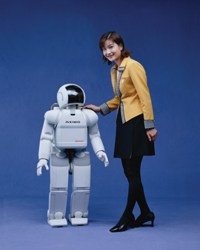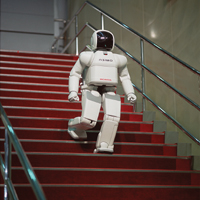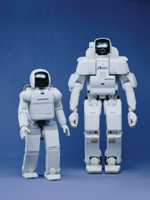These Bots Were Made for Walking
Back to Contents of Issue: February 2004
|
|
|
|
by Tony McNicol |
|
|
President Takeo Fukui has one of 30 Asimos in the corner of his office. Easier to find space for than a Formula One car, no doubt.
J@pan Inc visited the Honda head office and found a slightly forlorn Asimo standing on a podium in the spacious showroom. Yuji Hatano of the company's corporate communications department made our introductions.
Asimo stands for "Advanced Step in Innovative Mobility." It's also a pun on the Japanese for foot (ashi) and the English word "move." The robot's name, according to Hatano, has absolutely nothing to do with Isaac Asimov, the Russian-born science fiction writer.
"Honda is a company that pursues 'mobility,' " Hatano says. "Things that move. In the 40s we made motorbikes, in the 60s cars. Making Asimo was about thinking what to do 20 or 30 years ahead."
Asimo is about the size of an elementary school child and weighs around 50 kilos. He's about the right height to look a sitting human in the eye. According to Hatano, the present height is about right for a "household" robot. Any bigger and they might be a little unnerving striding across the tatami.
"Even cars are scary, when they come close," points out Hatano. "But cars don't come into your home."
With a walking speed of up to 1.6 kilometers an hour (pretty fast for a figure that height) you wouldn't want Asimo's weight crashing into you. "We aim to bring his weight down," Hatano admits.
Honda's first independent two-legged robot, the P2, was 180cm high and weighed almost 200 kilograms.
Since then the robots have been getting gradually smaller, although Hatano points out that larger robots would be useful as security guards.
When the company started the project in the mid-80s, its medium-term goals were to produce a robot capable of walking on two legs and, in the process, develop new precision technology useful for the company's main products.
At a time when it was becoming clear that future cars would rely on electronics as much as mechanics, the idea of developing a "walking computer," as Hatano describes Asimo, seemed smart.
That much has been achieved, but marketing a humanoid robot still seems to be a long way off.
Asimo is designed to be a "household robot," says Hatano, "[but] if you are talking about sales, then industrial robots are the quickest way to raise your revenues." Safety issues and the complicated, changing setup of the average home mean that it is much more likely that robots are going to take their first steps in controlled industrial environments. And companies are probably more likely to be prepared to pay for a device that costs about the same as a new Honda automobile.
"We must find some real applications within that time period, because we need a big investment of the order of several million US dollars a year to continue development."
Hirukawa participated in the five-year project funded by the Ministry of Economy, Trade and Industry to build humanoid robots, develop software and investigate possible applications in industry and elsewhere. Starting around the time of Honda's first public prototype, the project involved working with private companies, including Honda, as well as academic research groups.
But why build humanoid robots when specialized non-humanoid robots already work perfectly well in factories all over the world?
Hirukawa has stock replies to the question. First, he says, people want to work with humanoid robots. "When we see Asimo or Sony's robot we are attracted to them; there is an emotional reaction. And because the robot has the same shape and size as a human, it can use machines or tools which were developed for humans. This means that the robot can operate in a human work-space without any alteration to that environment."
The latter point is particularly important because it may be tied to the economic viability of humanoid robots. For example, NASA and DARPA (the Defense Advanced Research Projects Agency) are currently at work on a project to develop a robotic astronaut. The thinking behind the project is that it would be cheaper to develop a humanoid robot that can use astronaut tools and equipment than to redesign the whole spacecraft. Likewise, why rearrange the entire work space when it might be cheaper to buy a humanoid factory robot that can use doors, corridors and stairs?
A list of some of the companies taking part in the project gives some idea of possible applications: Mitsubishi Heavy Industries (maintaining industrial plants), Sogo Security Services (robot security guards), Hitachi (robot care staff for the elderly), Kawasaki Heavy Industries (operating industrial vehicles) and Kawada Industries (working with humans lifting and carrying). All are major players in their industries.
Hirukawa is now particularly interested in "applications in dangerous environments, for example, rescue work or maybe tunnel construction work -- or even work in dioxin-contaminated dumps."
The Humanoid Robotics Project came to the end of its five years in 2003. One product was HRP-2, a programmable humanoid robot that the group has loaned out to several different universities in Japan. A second product was the development of software and applications for the robot which demonstrated that the robot could perform simple tasks.
Still, if it's going to take 20 years to develop a market for industrial humanoid robots, who is going to pay for the research until then?
The government-funded Humanoid Robotics Project received around $40 million over the full five years. Hirukawa guesses that Asimo cost that much each year of its development.
"The biggest reason [why Japan is funding this research] is that Honda has already proved that such technology can be feasible. In Japan, if some deputy director of some division in the government likes an idea, we can get a budget. That's a major reason. Of course, abroad it's not so easy, because we cannot see or propose any definite applications for the robots so far."
According to the UN Economic Commission for Europe, perhaps not.
The commission's 2003 World Robotics survey forecasts that 2.1 million service robots are likely to be sold worldwide by 2006. That includes robotic vacuum cleaners, lawn mowers and window-cleaners among other contraptions. The figure doesn't include entertainment robots (many of which are relatively inexpensive), which could sell almost as many again.
Evidently people aren't entirely averse to allowing robots into their homes.
As for industrial robots, the same report records that while Japan still has almost half of all the robots used in industry worldwide, the total number of robots within the country peaked in 1997 and has been falling steadily since -- largely due to the recession and the outsourcing of manufacturing to China and elsewhere. Yet the worldwide demand for robots increased by 25 percent in 2003.
As Hirukawa points out, if Japan wants to step forward into the robotopia, researchers need to hold onto the advantage that the 10 years of intense work on humanoid robots has given them. "It's not easy to apply these robots to real applications. But Honda invested a lot of money in this technology, and now Japanese companies have the best technology in the field. If we stop the development now, this investment will be lost forever." @
|
|
Note: The function "email this page" is currently not supported for this page.


 Honda's development of its humanoid robot, Asimo, isn't the company's first step into unknown technological territory for the company. In the early 60s the motorcycle manufacturer surprised the automobile industry by rolling out its first sports car. Just two years later, Honda had its first Formula One Grand Prix win.
Honda's development of its humanoid robot, Asimo, isn't the company's first step into unknown technological territory for the company. In the early 60s the motorcycle manufacturer surprised the automobile industry by rolling out its first sports car. Just two years later, Honda had its first Formula One Grand Prix win.
 Professor Hirohisa Hirukawa of the Humanoid Robotics Project says that viable applications for humanoid industrial robots have to be found within the next five years.
Professor Hirohisa Hirukawa of the Humanoid Robotics Project says that viable applications for humanoid industrial robots have to be found within the next five years.
 So is the idea of a robot in every home just a sci-fi fantasy of over-funded robot researchers?
So is the idea of a robot in every home just a sci-fi fantasy of over-funded robot researchers?



